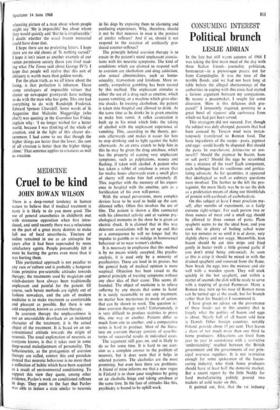Cruel to be kind
MEDICINE JOHN ROWAN WILSON
There is a deep-rooted tendency in human nature to believe that if medical treatment is nasty it is likely to do you more good. The use of general anaesthetics in childbirth met with strenuous opposition when first intro- duced, and until recently there was a reluctance on the part of a great many dentists to make full use of local anaesthesia. Tincture of iodine remained in use as an antiseptic for years after it had been superseded by more satisfactory agents. People presumably felt it must be hurting the germs even more than it was hurting them.
This puritanical approach is not peculiar to any race or-culture and is probably a hangover from primitive pre-scientific attitudes towards therapy; the treatments used by magicians and witch-doctors have always been traditionally unpleasant and painful for the patient. Of course, such heroic methods are rightly out of fashion nowadays, and the aim of modern medicine is to make treatment as comfortable and pleasant as possible. But there is one odd exception, known as aversion therapy.
In aversion therapy the unpleasantness is not an unavoidable drawback or an incidental character of the treatment, it is the actual object of the treatment. It is based on an un- conventional attitude towards the origin of neurosis. The usual explanation of neurosis, as everyone knows, is that it takes root in some deep-seated` maladjustment of personality. The behaviourists, as the protagonists of aversion therapy are called, contest this and postulate instead that neurotic behaviour is no more than a collection of habits which have been acquired as a result of environmental conditioning. To support this view they quote, among other evidence, Pavlov's work on conditioned reflexes in dogs. They point to the fact that Pavlov was able to induce a state similar to neurosis
in his dogs by exposing them to alarming and confusing experiences. Why, therefore, should it not be that neurosis in man is the product of similar reflexes? And if so, should it not respond to the creation of artificially pro- duced counter-reflexes?
The principle behind aversion therapy is to create in the patient's mind unpleasant associa- tions with his neurotic symptoms. The kind of conditions which are claimed to respond well to aversion are alcoholism and drug addiction, also sexual abnormalities, such as homo- sexuality, tranvestism and fetishism. More re- cently, compulsive gambling has been treated by this method. The unpleasant stimulus is either -the use of a drug such as emetine, which causes vomiting, or a machine which gives elec- tric shocks. In treating alcoholism, the patient is taken into hospital and allowed to drink. At the same time as he drinks he is given emetine to make him vomit. A reflex association is built up in his mind which links the taking of alcohol with the unpleasant experience of vomiting. This, according to the theory, per- sists afterwards and makes it easier for him to stop drinking and to fight against the habit afterwards. As an extra crutch to help him in this he may be given the drug antabuse, which has the property of causing very unpleasant symptoms, such as palpitations, nausea and flushing, if taken with alcohol. A patient who has taken a tablet of antabuse is aware that for twelve hours afterwards even a small glass of sherry will make him feel extremely ill. This, together with the memory of his experi- ence in hospital with the emetine, acts as a fortification of his own will-power.
With the sexual perversions, more complex devices have to be used to build up the con- ditioned reflex. Often this involves the use of film. The patient is shown a film connected with his abnormal activity and at various psy- chological moments in the show he is given an electric shock. It is claimed that in this way deterrent associations will be set up and that as a consequence he will no longer feel the impulse to gamble or to indulge in homosexual behaviour or to wear women's clothes.
It is necessary to emphasise that this method is by no means widely accepted; like psycho- analysis, it is used only by a minority of psychiatrists. These are loud in its praises, but the general body of medical opinion is more sceptical. Objection has been raised to the general principle of treating symptoms without any clear idea of their cause. This seems ill- founded. The object of medicine is to relieve suffering by any means that come to hand. It is surely reasonable to use any treatment, no matter how mysterious its mode of action, that can be shown to work. The question is: does aversion therapy work? Unfortunately, it is very difficult to produce statistics to prove this, one way or another. Patients differ so much from one to another, and a comparative series is hard to produce. Most of the litera- ture on aversion therapy consists of case-his- tories of successful results in individual cases.
The argument still goes on, and is likely to do so for some time. It is hard to see aver- sion as a complete answer to the problem of neurosis, but it does seem that it helps in selected patients. The alcoholics are the most promising, but even here there are problems. A friend of mine informs me that a new vogue in Finland is to show your toughness by going on an alcoholic binge and taking antabuse at the same time. In the face of attitudes like this, psychiatry is bound to be uphill work.










































 Previous page
Previous page